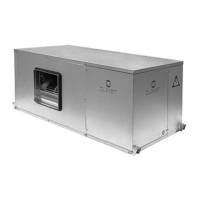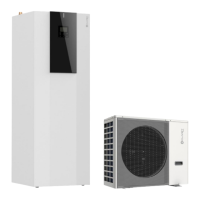20
8 - CONTROL
ALARM LIST
The ALARMS indicate a potentially hazardous situation for the machine integrity.
Before resetting the alarm, identify and remove the reason of the lock: a repeated reset can cause irreversible damage. That's why the
reset is MANUAL, namely through keyboard (provided that the cause no longer exists).
PRE-ALARMS and SIGNALS indicate a close risk situation. Their occurrence can be accepted if occasional and/or in temporary situa-
tions (for example at the system start-up).
The reset is AUTOMATIC, that is there is a self-reset as soon as the cause ceases without any keyboard intervention.
FAILURES signal the malfunctioning of probes and transducers; they are AUTOMATICALLY reset, so that anyway the unit can oper-
ate, even if possibly with reduced functions.
In case of doubt contact an authorized service center.
The presence of one or more alarms is signalled by the ALARM CODE blinking and by the machine time it/they occurred.
The cumulative lock relay activates simultaneously with the alarm code displaying.
Some alarms, typically PRE-ALARMS, do not activate the relay.
The table shows all the variables which can be managed by the electronic system.
According to the machine configuration and the accessories, some alarms can be not relevant.
Code Alarms reset
I/O on
1 compr. board
I/O on
2 compr. board
E01 Inlet temp. Probe fault fault Automatic 2.1 2.1
E02 Outlet temp. Probe fault Automatic 2.2 2.2
E03 Externe temperature probe fault Automatic 2.3 2.3
E04 Ambient UR% probe fault Automatic 2.9 3.7
E05 Externe UR% probe fault Automatic 3.8 3.8
E06 Air qualità probe fault Automatic 3.11 3.11
E07 Fire alarm Manual 1.3 1.3
E08 Outlet fan protection intervention Manual 1.7 1.7
C9 Clogged filter signal Automatic 1.8 1.14
E10 Aux. heater overtemperature alarm Manual 1.10
E11 Antifreeze alarm Manual 1.9 1.15
C12 Outlet high temp. signaling Automatic 1.10
C13 Outlet low temp. signaling Automatic
E14 Cond. pressure probe fault. - 1" Automatic
E15 Cond/evap. pressure probe fault - 1 Automatic 2.8 2.8
E16 High pressure alarm - 1 Manual 1.5 1.5
C17 - E17 Low pressure alarm - 1 Automatic 1.4 1.4
E18 Compressor / fan safety device intervention -1 Manual 1.6 1.6
E19 Condenser / evap. water-flow alarm -1 Automatic
C20 High pressure –1 prealarm 1 Automatic
C21 - E21 High pressure –1 prealarm 2 Automatic
C22 - E22 Low pressure prealarm - 1 Automatic
C23 Defrosting forcing intervention - 1 Automatic
E24 Condensation temperature probe fault - 2 Automatic
E25 Cond./evap. pressure probe fault – 2 Automatic 2.9
E26 High pressure alarm – 2 Manual 1.10
C27 - E27 Low pressure alarm – 2 Automatic 1.8
E28 Compressor/fan safety intervention-2 Manual 1.9
E29 Condenser/evap. Water-flow alarm – 2 Automatic
C30 High pressure –2 prealarm 1 Automatic
C31 - E31 High pressure –2 prealarm 2 Automatic
C32 - E32 Low pressure prealarm - 2 Automatic
C33 Defrosting forcing intervention – 2 Automatic
E34 Internal handling coil temperature probe fault Automatic
E35 Unit configuration error Automatic
E36 Condenser temperature probe fault Automatic
E37 Condenser / water evap. antifreeze alarm Automatic
E00 Communication time out between thermostat and unit Automatic
E38 Overhetaing external water coil Automatic

